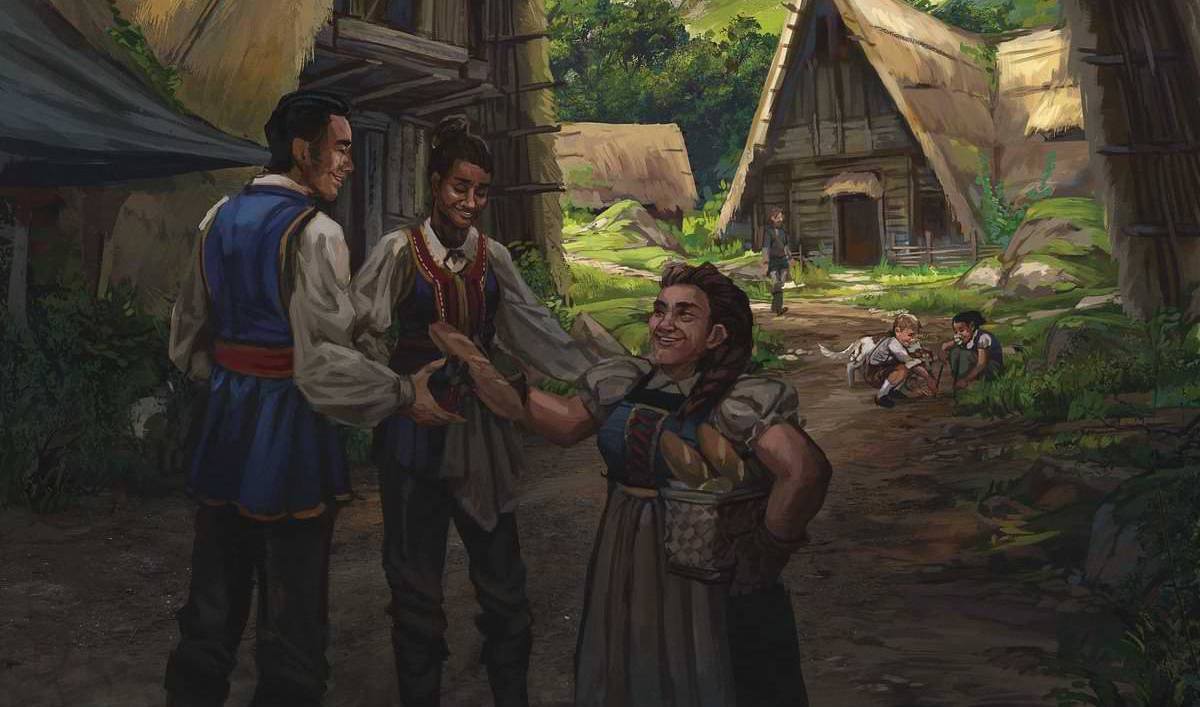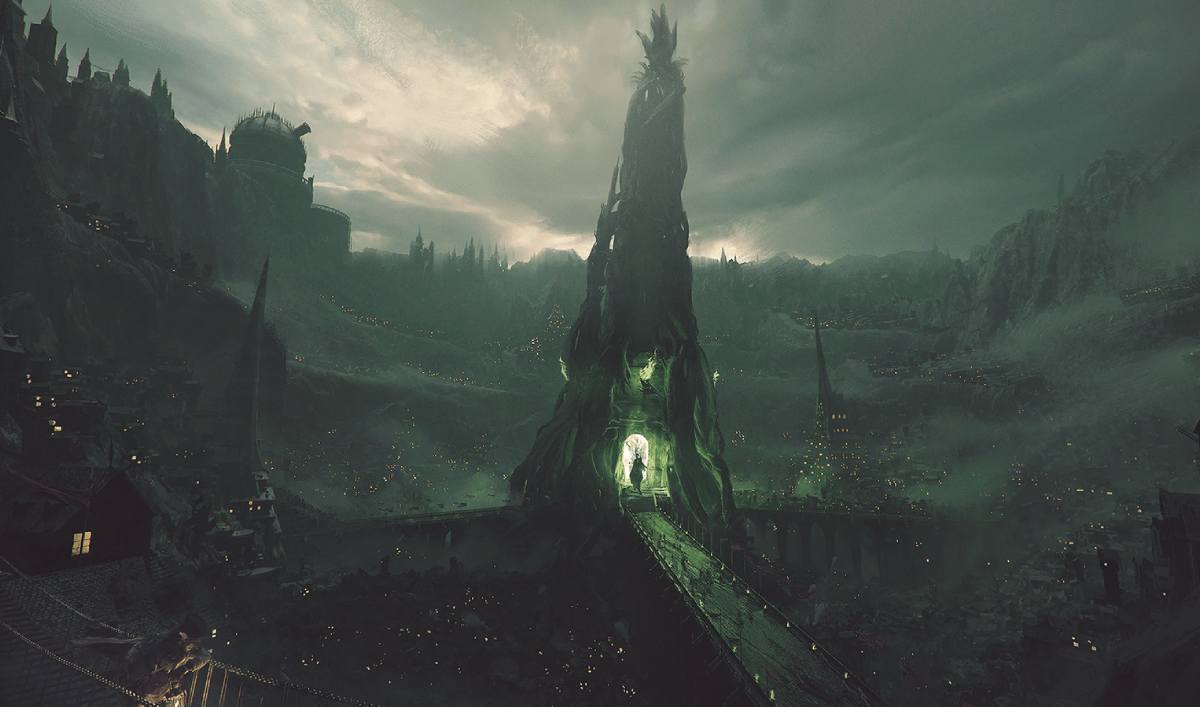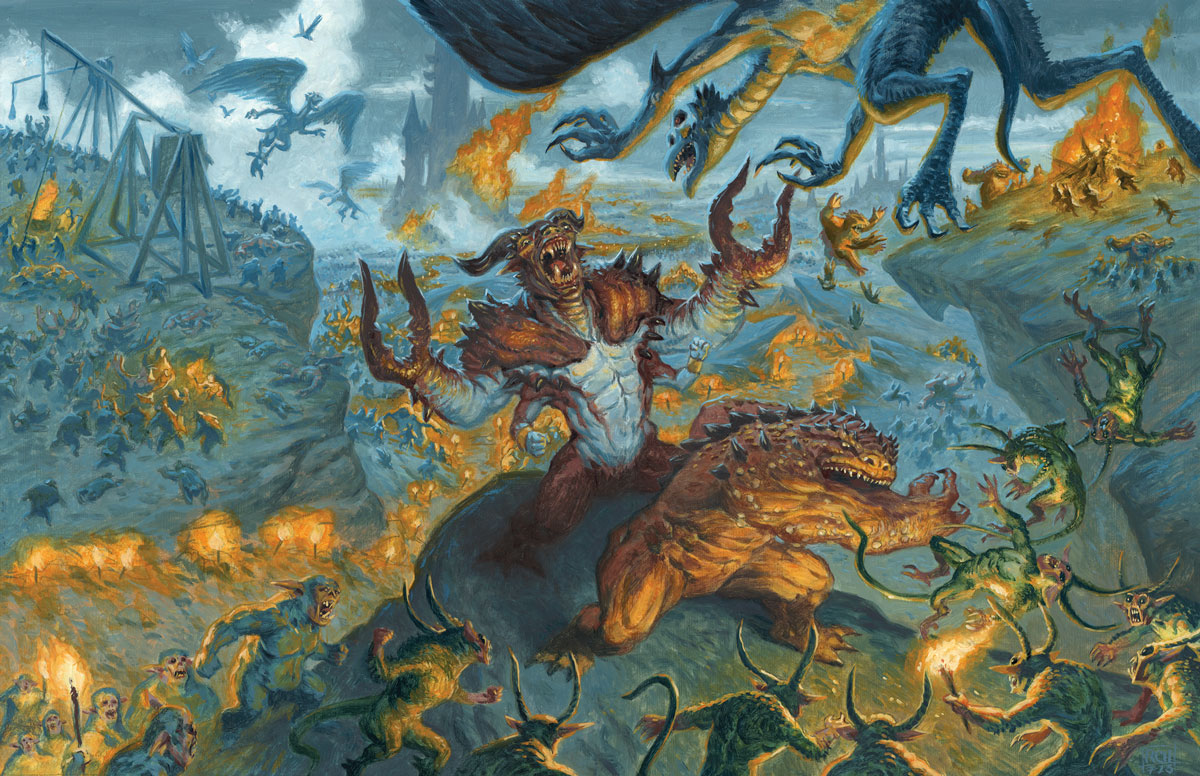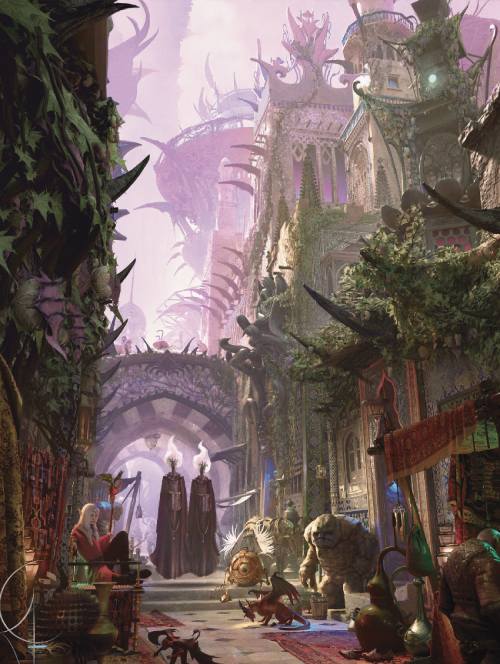Many Dungeon Masters, myself included, find that running D&D for higher-level characters can get challenging. It's difficult to pose meaningful, let alone interesting, obstacles for PCs once they cross the threshold of levels 12 to 13, and you have to get creative when it comes time to think of multiverse-ending conflicts. For higher-level adventures, like the upcoming Vecna: Eve of Ruin, you need to reframe the way you think of the game to keep your players feeling fulfilled.
If you are crafting your own high-level adventures, here are some useful tips for keeping your campaign engaging when you enter into higher-tier play.
4 Tips for Tier 4
- Use lower-tier quest structures but with more epic scope, such as armies of devils threatening an entire plane rather than Bandits threatening a village.
- Alien and exotic locations, such as the City of Brass or the Far Realm, can justify the characters having more grounded interactions even at much higher levels of play.
- Don’t threaten the characters. Threaten what they value.
- Gold and magic items become less valuable rewards. Instead, offer renown, boons, power, and influence.
What Are Tiers of Play in D&D?

D&D is broadly divided into four level ranges of play, referred to as tiers. Each tier represents a different scale at which the players engage with the world. Tiers of play are described in the 2014 Dungeon Master’s Guide, but here’s a summary:
Tier 1: Levels 1-4 - Local Heroes
Tier 1 is where your players are still figuring out their classes and deciding how to specialize their character by unlocking subclasses. Magic items are few and far between, and spells are generally cantrips and lower level. Adventures are on the scale of saving towns and villages from local threats such as Bandits or maybe an evil wizard.
Tier 2: Levels 5-10 - Heroes of the Realm
In this tier, your players move up from saving small areas to saving entire regions. Rather than fighting bandits and wizards, they might clash with dragons and necromancers with Undead armies. By now, it’s assumed the players are familiar with their classes, and it’s time to start getting into more powerful abilities; some spellcasters gain access to powerful spells such as Fireball, while some martial classes gain the ability to attack more times per action. Every character's proficiency bonus increases, as well, which is a big jump in power across the board.
Tier 3: Levels 11-16 - Masters of the Realm
Once players enter the third tier of play, they become paragons of the world they occupy, standing tall above all other heroes. The entire world's fate may rest in their hands, and their adversaries represent threats from beyond their plane, such as Aberrations from the Far Realm like Beholders or devils and demons from the Lower Planes.
The party will have the right tool in their arsenal for almost every situation, both in and out of combat. At this tier, the players will also have amassed resources beyond those of their classes; strongholds, small armies, or powerful allies will be at their disposal. Downtime might be more significant as they spend weeks, months, or even years between adventures crafting magical items or rallying people to their cause.
Tier 4: Level 17+ - Masters of the World
If, at tier 3, threats from beyond the Material Plane stood against the PCs, now the party takes the fight to them. Superheroes beyond mortal measure, tier 4 characters can do what would be considered impossible for almost anyone else. They can stand toe-to-toe with ancient dragons, invoke the power of the gods, or become immortal killing machines.
They traverse the planes, treat with angels, and broker with devils like the average person might barter with a merchant. The powers they command, and deeds they accomplish will be inscribed on the annals of history and sung by bards for centuries to come.
What to Expect Beyond Tier 2

Moving from tier 2 to tier 3 can be the most significant shift in how a campaign feels, and that is part of the reason many campaigns end around level 12 or 13. Challenging your players can become more difficult, both mechanically and narratively.
In tiers 3 and 4, your players will have access to raw destructive power and a massive array of utility options. Overworld travel can cease to be as meaningful thanks to spells such as Teleport and Word of Recall, while gathering information is made easier through the likes of Legend Lore. Martial characters will be unbreakable bulwarks, shielding the Fireball-flinging spellcasters, while classes like Rogues and Monks become blurs of speed and stealth.
When it comes to telling stories at these levels, the scope can become massive. Global politics and nation-spanning conspiracies become small-scale problems, while world-ending threats such as archliches, greatwyrms, and demon lords loom over entire planes of existence.
Your players will walk amongst figures spoken of only in legends, such as the Lady of Pain, Zariel, or even Tiamat herself.
Changing the Challenges

But how do you go about running campaigns at higher levels? Well, for all my talk of how different it is from lower-level play, one of the best pieces of advice I can give is to dress low-level adventure structures up in high-level presentation.
Let’s take a very simple tier 1 quest structure:
The small town of Exampleton, between the banks of the River Placeholder and Plot Hook Forest, is under threat. The warlord Beebee Eegee and his Bandits have been terrorizing the village from their camp hidden deep within the forest. The characters must travel through the dangerous forest, fend off Giant Spiders and Dire Wolves, infiltrate the camp, and slay Beebee.
This hook is fairly standard fare for low-level play and likely something you wouldn’t see outside of tier 1. Or is it?
Let’s take the same hook, or even better, the same text, and dress it up as a tier 4 questline:
The plane of Exampliar, between the astral banks of the River Styx and bordering on the Feywild, is under threat. The devil, Eind Baws, and her Fiends have been terrorizing the plane from their fortress deep within the Feywild. The characters must travel through the Ethereal Plane into the Feywild, fend off giants and dragons, infiltrate the fortress, and slay Eind.
The structure is nearly identical but is now scaled up as a suitable premise for high-level player characters. By taking low-level structures and upscaling them, you can build out suitable high-level adventure lines; the dungeon filled with gnolls within a shattered castle becomes a dungeon filled with demons within a shattered demiplane. Sailing the sea to a desert island to stop a yuan-ti ritual becomes spelljamming the Astral Sea to the remains of a dead god to stop a githyanki ritual. Same structure, bigger scope.
Same Structure, Unusual Locales

Speaking of scope, upscaling your locales can also make for fun tier 3 and 4 play. Even in the higher (and lower) planes of existence, there are towns and cities: the City of Brass in the Elemental Plane of Fire; Empyrea, the capital city of Mertion, the Platinum Heaven, the fifth layer of Mount Celestia; or even Sigil, the City of Doors.
Here, the players can rub shoulders with devils and demons, Celestials and Elementals, just like they used to rub shoulders with butchers, bakers, and candlestick makers back at level 1. These strange yet familiar settings can give your players space to explore being higher level without feeling quite so disconnected from those around them as they might in a more mundane city.
In my article on exploration design, I mentioned how I was running a 20th-level arc of my campaign, during which my players explored my setting's version of the drow capital of Menzoberranzan. I’ve been using the above philosophy to great effect as my players have felt powerful yet humbled as they rub shoulders with some of the most powerful drow in the Underdark.
We’re talking priestesses who can call on Lolth for profane miracles at a whim and where dark paladins patrol the streets enforcing the Spider Queen's laws. By making the city feel alien and disconnected from the world they know, hostile at every turn, and ruled over by individuals who command dark and disturbing amounts of power, my players have found new challenges to test their powers against.
Finally, there’s the matter of stakes and what the players are fighting for, or against, for that matter. It can start to feel like there’s nothing you can do to really threaten the PCs as they become able to recover from any blow, counter any spell, or simply become indestructible. However, just because the characters are invincible, that doesn’t mean those around them are.
The people living in the towns and cities the players have visited, the friends and allies they’ve made on their quests, or even just the common folk they feel a sense of connection to are still just as fragile. There’s a concept in character design called Knife Theory; a knife is anything in a character's backstory that the DM can use against them. This can be a loved one, a valued possession, or even a special location. At high levels, these proverbial knives become indispensable, so as a DM for tier 3 and 4 play, make sure you keep all your knives sharpened and close at hand because they’re going to be your main weapons.
A classic example of this approach is in the best way to use a Tarrasque. For a CR 30 monster, the Tarrasque isn’t that scary, and a level 20 or lower party could easily take one on with little risk.
But that assumes you’re deploying a Tarrasque as a head-on fight with the PCs. Instead, put the Tarrasque on a rampage directly toward the city where the party’s home base is, or where one of the PC’s families lives, or if you want to make the D in DM stand for Diabolical, where that adorable Goblin they rescued at level 3 now lives. It’s now no longer about killing the Tarrasque; it’s about killing the Tarrasque before it destroys the city where Boblin the Goblin lives!
There are stakes now that transcend the PCs dying; the knives are out, and the players are fighting against the clock, against a force of nature. All the level 20 abilities in the world won’t matter if they take too long, and even if they do succeed, at what cost?
Victory in D&D isn’t always about the party walking away alive—sometimes, there’s so much more at stake.
Level 20 and Beyond
While it’s fair to say that running D&D as a Dungeon Master can become increasingly difficult the higher the party’s level goes, hopefully these tips help you avoid tiering your hair out over tier 4 play.
If I were to summarize my advice into a single point, it would be to remember that high-level play can always be approached much in the same way as low-level play but dressed up with bigger and more dramatic styling. And if you need some inspiration for higher-level play, don’t forget to check out Vecna: Eve of Ruin, releasing May 21. This adventure for 10th- to 20th-level characters will take your party to iconic locations across the multiverse as they race to stop Vecna the lich-god from completing a multiverse-destroying ritual!

Davyd is a moderator for D&D Beyond. A Dungeon Master of over fifteen years, he enjoys Marvel movies, writing, and of course running D&D for his friends and family, including his wife Steph and his daughter Willow (well, one day). They live with their two cats Khatleesi and Mollie in the south of England.








-
View User Profile
-
Send Message
Posted May 4, 2024Tip number 9 is my favorite
-
View User Profile
-
Send Message
Posted May 5, 2024Wonderful suggestions - suddenly The Isle of Dread as an Astral Plane adventure is coming to mind!
-
View User Profile
-
Send Message
Posted May 5, 2024Going to more exotic and far out locations sounds great, but we dont know a whole lot about the locations you mentioned like The City of Brass or The Far Realm.
We're all familiar with the Sword Coast for the most part but I dont think we've ever seen what Mechanus or Bytopia even looks like. The Planescape book was okay for the Outlands (but again with missing info on what some of the locations are like), what about a 5th Edition Manual of the Planes?
-
View User Profile
-
Send Message
Posted May 5, 2024That's exactly the kind of thing I do. Take the adventure structure, reframe the context, and then cut and replace the monsters.
Usually what I'll do is look for monsters of the same creature type, but a more suitable CR
-
View User Profile
-
Send Message
Posted May 5, 2024For a CR 30 monster, the Tarrasque isn’t that scary, and a level 20 or lower party could easily take one on with little risk.
from wotc that’s saying a lot
-
View User Profile
-
Send Message
Posted May 5, 2024I’d say that even a level 8 party with the right spells could take out a Tarrasque
-
View User Profile
-
Send Message
Posted May 5, 2024Excellent article! I just wish it was written 2 years ago when I was running a rather underwhelming Tier 4 campaign finale!
-
View User Profile
-
Send Message
Posted May 6, 2024I like these suggestions. I've run and played in campaigns at the highest level (17-20) and they aren't intrinsically different than those at lower levels. It's the settings, the stakes, and the players that change. Putting PCs under time pressure is one way of dealing with high-level resources. Taking them out of their comfort zone (by placing them in unusual environs) can help create tension in encounters. Just how powerful is that being they are dealing with exactly? What resources do they have? Should I use social skills to circumvent this difficulty instead of fighting through it? High level characters have earned the right to be the pinnacles of their worlds, but even they can be caused to take pause in the right situation. Thanks for the article!
-
View User Profile
-
Send Message
Posted May 6, 2024I'm not going to rehash whole essays worth of issues that's already discussed deeply on many websites by the D&D community, but the negativity around it is going to shape what one writes about when one's position depends on promoting the products.
But to give a few examples of what I wanted to see, it would be ways to remind or overcome issues that beginner DMs might not think about.
D&D technically says they don't account for magic items in balancing and level, but unless you're a specific martial character like a monk who's lvled enough to count their attacks as a magical, those martials will need magic weapons to overcome the many monsters that have resistance or immunity to nonmagical physical attacks, or don't have ranged for flying or teleporting enemies. Its either halved damage or no damage depending on the fights.
Giving outs for martials to overcome spells like Forcecage that basically take them out of the fight.
How CR increasingly is less reliable to balance encounters, with HP often needing to be boosted from bosses dying too fast and not having enough action economy even with legendary actions. Mythic forms somewhat solved this, but it should definitely be warned about.
For those DMs who don't allow multiclassing, martials in late game have very few options relative to others and often need more magic items to keep up.
AC becoming near worthless to overcome with higher stats and proficiencies for both party and foes, aside from specific builds.
Needing huge amounts of encounters, traps, challenges, per day to get through all the resources, particularly for spellcasters. It was already challenging given there is usually only 1 to 3 encounters per day at lower levels without the dungeon crawls this balance of resources was designed around.
Preparing for Wish spells, how it would be interpreted at the table for the big uses of them, especially with multiple users. Same with opposing npcs that can also use it.
Simulacrum basically adding an extra fragile member, action economy, and of course all the cheese.
Res spells, how death and raising is handled, as a trivial thing or serious soul killing thing or just banning them.
Often needing ways to counteract all the utility, like anti-teleport, anti-scry, anti-antimagic, that locations and villains often need, and how players would feel about it.
The incredible ways downtime can be used with casting higher level spells each day, and how that might break immersion for the world.
If using specific coin amounts, how crazy the accounting gets with hundreds of thousands of gold and all range of items and buildings and hirelings bought.
How to handle armies of foes, given at some point characters can destroy nations.
The crazy amount of worldbuilding on scales many DMs are unfamiliar with, as eldritch horrors and pantheons threaten continents, worlds, multiverses, etc. How to direct it or ignore it.
Cheese, just all the cheese, from breaking the economy to taking out foes like Zariel with ease with all the min-maxing.
Carefulness in using higher level spells against the party. If they don't have a way to overcome stuff like Dominate spells or Feeblemind, they are effectively removed, so they need ways to recover from it.
Enchantment spells and other taboo uses with them that are normally not thought about as they and the enemy gain ever more power with them.
Scheduling in itself over many months and years, as most campaigns simply end before these levels are reached and many conclusions never happen or are forced to happen fast. Its an easy trap to get into, as DMs like mythic arcs across such vast scales, and few think about their real life schedule limits until it is too late.
And so on and so forth. This is just the tip of the iceberg. The sheer amount of it basically gave me a mental breakdown as this was on top of all the standard stuff I had to account for a D&D campaign, like character arcs, NPCs and factions, plot points, etc, that only gets worse the more you play and it keeps piling up.
-
View User Profile
-
Send Message
Posted May 6, 2024That would be epic on D&D Beyond. It would be sweet if we could use epic boons and even prestige classes.
-
View User Profile
-
Send Message
Posted May 7, 2024Great article. Thanks for your wisdom!
-
View User Profile
-
Send Message
Posted May 7, 2024Dang this all really good info for DMing at higher levels
-
View User Profile
-
Send Message
Posted May 7, 2024Any character building tips for DM's when it comes to starting at level 10 like in Vecna: Eve of Ruin? Any tips for DMs in that book?
Mainly, what type of gear do you give or allow those players to have?
-
View User Profile
-
Send Message
Posted May 7, 2024Great article! Thanks for writing it!!
-
View User Profile
-
Send Message
Posted May 7, 2024Davyd, couldn’t help but notice if you’re doing a high-level campaign in the Drow capital, would you happen to have made a Lolth stat block? If so, would you be kind enough to share it with the community?
-
View User Profile
-
Send Message
Posted May 8, 2024Correct.
-
View User Profile
-
Send Message
Posted May 9, 2024For making characters, I just advise my players to start at level one and take it slowly as they make their choices. Make their characters as if they were playing through a campaign; one level at a time.
For deciding gear when starting at a higher level, I'll usually jot down a very rough campaign structure up to that level, then note what the major and minor beats would be. I'm talking a very rough bullet point list level by level. So for example:
With that list, I can then mark where I'd drop magic items:
Minor and major in this case just means items that are nice and items that are flashy and personalised respectively. So I know roughly I want 22 minor items and 13 major items, give or take. For a party of four, I'll translate this to about 5 ish minor items and 3 ish major ones. I'll then convert that into a rarity spread and let my players pick. So I might say
I will also ask to see their picks beforehand so I can identify any items I wouldn't have given out because they don't fit the flow.
-
View User Profile
-
Send Message
Posted May 9, 2024I actually reskinned the Arasta stat block from Mythic Odysseys of Theros for when my players fought Lolth.
-
View User Profile
-
Send Message
Posted May 9, 2024I was planning on doing the same.
-
View User Profile
-
Send Message
Posted May 9, 2024Good idea